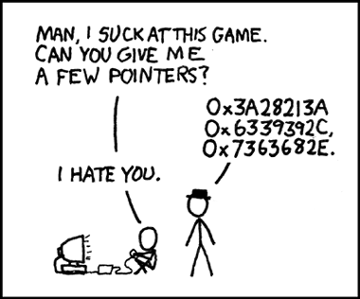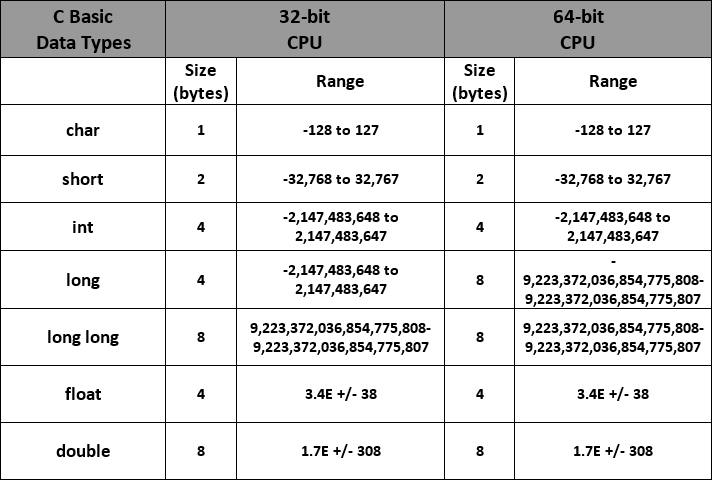Pointers & Addresses
-
Pointer: A pointer is like a special variable in programming that holds the memory address of another variable. Instead of storing a value directly, it stores the location in memory where the value is kept.
-
Address: An address in programming is the unique location in memory where a piece of data (like a variable) is stored. It’s like the “home address” for that data in your computer’s memory.

What is 32-bit or 64-bit Processor in CPU?
The terms 32-bit and 64-bit refer to the width of the processor’s registers, which are the small storage locations in the CPU that the processor uses to handle data.
-
32-bit Processor: A 32-bit processor can handle data and memory addresses that are 32 bits wide. This means it can directly access up to 4 GB (gigabytes) of RAM (2³² addresses). It’s generally less powerful than a 64-bit processor because it can process smaller chunks of data at a time.
-
64-bit Processor: A 64-bit processor can handle data and memory addresses that are 64 bits wide. This allows it to access a much larger amount of RAM and process larger chunks of data at once. It’s more powerful and efficient, especially for tasks that require handling large amounts of data or running multiple applications simultaneously.
In simple terms, a 64-bit processor is more powerful and can handle more memory and data than a 32-bit processor.

Data Types in C
In C programming, data types specify the type of data that a variable can hold. Here’s a breakdown of the primary data types in C:
1. Basic Data Types
int: Used to store integers (whole numbers) without any decimal points.- Example:
int age = 25;
- Example:
float: Used to store floating-point numbers (numbers with decimals).- Example:
float price = 19.99;
- Example:
double: Similar tofloat, but with double the precision, allowing for more decimal places.- Example:
double pi = 3.141592653589793;
- Example:
char: Used to store single characters (like ‘a’, ‘B’, or ‘1’).- Example:
char grade = 'A';
- Example:
2. Derived Data Types
array: A collection of elements of the same data type.- Example:
int numbers[5] = {1, 2, 3, 4, 5};
- Example:
pointer: Stores the memory address of another variable.- Example:
int *ptr = &age;
- Example:
struct: A user-defined data type that allows combining different types of variables under one name.- Example:
struct Student { char name[50]; int age; float gpa; };
- Example:
union: Similar tostruct, but all members share the same memory location.- Example:
union Data { int i; float f; char str[20]; };
- Example:
3. Enumeration (enum)
enum: A user-defined type consisting of a set of named integer constants.- Example:
enum Weekday {Sunday, Monday, Tuesday, Wednesday, Thursday, Friday, Saturday};
- Example:
4. Void Type
void: Represents the absence of type. It’s often used with functions to indicate they return no value.- Example:
void functionName() { /* code */ }
- Example:
Each of these data types serves specific purposes and helps in efficient memory management and execution of C programs.

Adavantages and Disadvantage of Pointers?

| Advantages of Pointers | Disadvantages of Pointers |
|---|---|
| Efficient Memory Management | Complexity and Bugs |
| Dynamic Memory Allocation | Memory Management Issues |
| Array and String Manipulation | Security Risks |
| Function Pointers for Flexible Code | Portability Issues |
| Multiple Return Values from Functions | Indirect Access (Potential Slower Execution) |
| Low-Level Programming | Difficult Debugging |
Why the size of pointer of all datatypes is same?
The size of a pointer is the same for all data types because a pointer’s value is simply a memory address, and the size of a memory address is determined by the system architecture, not by the type of data the pointer points to.
- Memory Address Representation:
- A pointer stores the memory address of a variable. The size of the memory address is fixed by the computer’s architecture (e.g., 32-bit or 64-bit), regardless of what type of data is stored at that address.
- Architecture Dependency:
- On a 32-bit system, a memory address is 32 bits (4 bytes) long, so all pointers (whether to
int,char,float, etc.) will be 4 bytes in size. - On a 64-bit system, a memory address is 64 bits (8 bytes) long, so all pointers will be 8 bytes in size.
- On a 32-bit system, a memory address is 32 bits (4 bytes) long, so all pointers (whether to
- Type of Data Doesn’t Affect Address:
- The type of data (e.g.,
int,char,double) only affects how the pointer is interpreted or dereferenced (i.e., how the data at the memory address is read or written), not the size of the pointer itself.
- The type of data (e.g.,
Pointers in Java?
Java does not use explicit pointers like C/C++. Instead, it uses references, which are abstract handles to objects in memory. Java’s memory management, including garbage collection, is automatic, eliminating the need for pointer manipulation and reducing risks like memory leaks and security vulnerabilities. This abstraction makes Java safer and more portable across different platforms.
Multi Pointers (Double , Triple etc?)
In languages like C and C++, multi-level pointers (e.g., double pointers, triple pointers) refer to pointers that point to other pointers. Here’s a quick overview:
- Single Pointer: Points to a variable.
- Example:
int *ptr;(points to anint).
- Example:
- Double Pointer: Points to a pointer, which in turn points to a variable.
- Example:
int **ptr2;(points to anint *, which points to anint).
- Example:
- Triple Pointer: Points to a double pointer.
- Example:
int ***ptr3;(points to anint **, which points to anint *, which points to anint).
- Example:
Use Cases:
- Dynamic Memory Allocation: Useful in scenarios involving arrays of pointers or when dealing with multi-dimensional arrays.
- Function Arguments: Passing a pointer to a pointer allows functions to modify the pointer itself, such as in dynamic memory allocation functions.
Example:
int value = 10;
int *ptr1 = &value; // Single pointer
int **ptr2 = &ptr1; // Double pointer
int ***ptr3 = &ptr2; // Triple pointer
printf("%d\n", ***ptr3); // Output: 10
In this example, ptr3 is a triple pointer that eventually points to the value 10. Each level of pointer indirection adds a layer of reference to the original data.
Function Pointers
Function pointers in languages like C and C++ are pointers that point to functions rather than data. They are used to store addresses of functions and can be passed as arguments to other functions, enabling dynamic function calls and more flexible code.
Key Concepts:
- Declaration: A function pointer is declared with the return type and parameter types of the function it can point to.
- Example:
int (*funcPtr)(int, int);declaresfuncPtras a pointer to a function that takes twointparameters and returns anint.
- Example:
- Initialization: Assign the address of a function to the function pointer.
- Example:
int add(int a, int b) { return a + b; } int (*funcPtr)(int, int) = add; // Initialize function pointer
- Example:
- Usage: Call a function through its pointer using the dereference operator
*.- Example:
int result = (*funcPtr)(5, 3); // Calls the add function via funcPtr
- Example:
Example:
#include <stdio.h>
// Function to be pointed to
int multiply(int a, int b) {
return a * b;
}
// Function that takes a function pointer as an argument
void operate(int (*operation)(int, int), int x, int y) {
printf("Result: %d\n", operation(x, y));
}
int main() {
int (*funcPtr)(int, int) = multiply; // Function pointer to multiply
operate(funcPtr, 4, 5); // Pass function pointer to operate function
return 0;
}
Benefits:
- Callback Functions: Allows passing functions as arguments, useful for callback mechanisms.
- Dynamic Behavior: Enables choosing or changing functions to call at runtime.
- Improved Modularity: Facilitates separation of function logic and function calls.
Function pointers are a powerful feature that allows for more dynamic and flexible program design but require careful handling to avoid issues like invalid function calls or memory errors.
Sample Q and A’s.
Problem: Implement a Simple Calculator
Create a simple calculator that uses function pointers to perform basic arithmetic operations. You should:
- Define functions for addition, subtraction, multiplication, and division.
- Implement a function that takes two integers and a function pointer to an operation function.
- Use function pointers to perform the selected operation and print the result.
Example Functions:
int add(int a, int b);
int subtract(int a, int b);
int multiply(int a, int b);
float divide(int a, int b);
void performOperation(int (*operation)(int, int), int a, int b);
Problem: Implement a Sorting Function with Callback
Create a sorting program that can sort an array of integers using different comparison strategies defined by function pointers. You should:
- Define comparison functions for ascending and descending order.
- Implement a sorting function that takes an array, its size, and a function pointer to the comparison function.
- The sorting function should use the comparison function to sort the array.
Example Functions:
void sort(int arr[], int size, int (*compare)(int, int));
int compareAsc(int a, int b);
int compareDesc(int a, int b);
void printArray(int arr[], int size);
Problem: Implement a Generic List with Sorting
Create a generic list data structure that can store elements of any type and support operations like adding elements, printing the list, and sorting the list based on a comparison function. You should:
- Implement a
Liststructure that can dynamically grow and store elements. - Define functions to add elements to the list, print the list, and sort the list.
- Use function pointers to handle different comparison strategies for sorting.
Requirements:
- Define a Generic List:
- Implement a list structure that can hold elements of any type using
void*for generic storage. - Include fields for the list’s size, capacity, and a pointer to the elements.
- Implement a list structure that can hold elements of any type using
- List Operations:
- Implement functions to:
- Initialize the list (
initList). - Add elements to the list (
addElement). - Print the list (
printList), using a function pointer for custom printing. - Sort the list (
sortList), using a function pointer for the comparison function.
- Initialize the list (
- Implement functions to:
- Testing:
- Create a list of integers and a list of strings.
- Implement comparison functions for sorting integers and strings.
- Test adding, printing, and sorting operations.
Example Function Declarations:
typedef struct {
void **elements;
size_t size;
size_t capacity;
} List;
void initList(List *list);
void addElement(List *list, void *element);
void printList(List *list, void (*printFunc)(void *));
void sortList(List *list, int (*compareFunc)(const void *, const void *));
int compareInt(const void *a, const void *b);
int compareString(const void *a, const void *b);